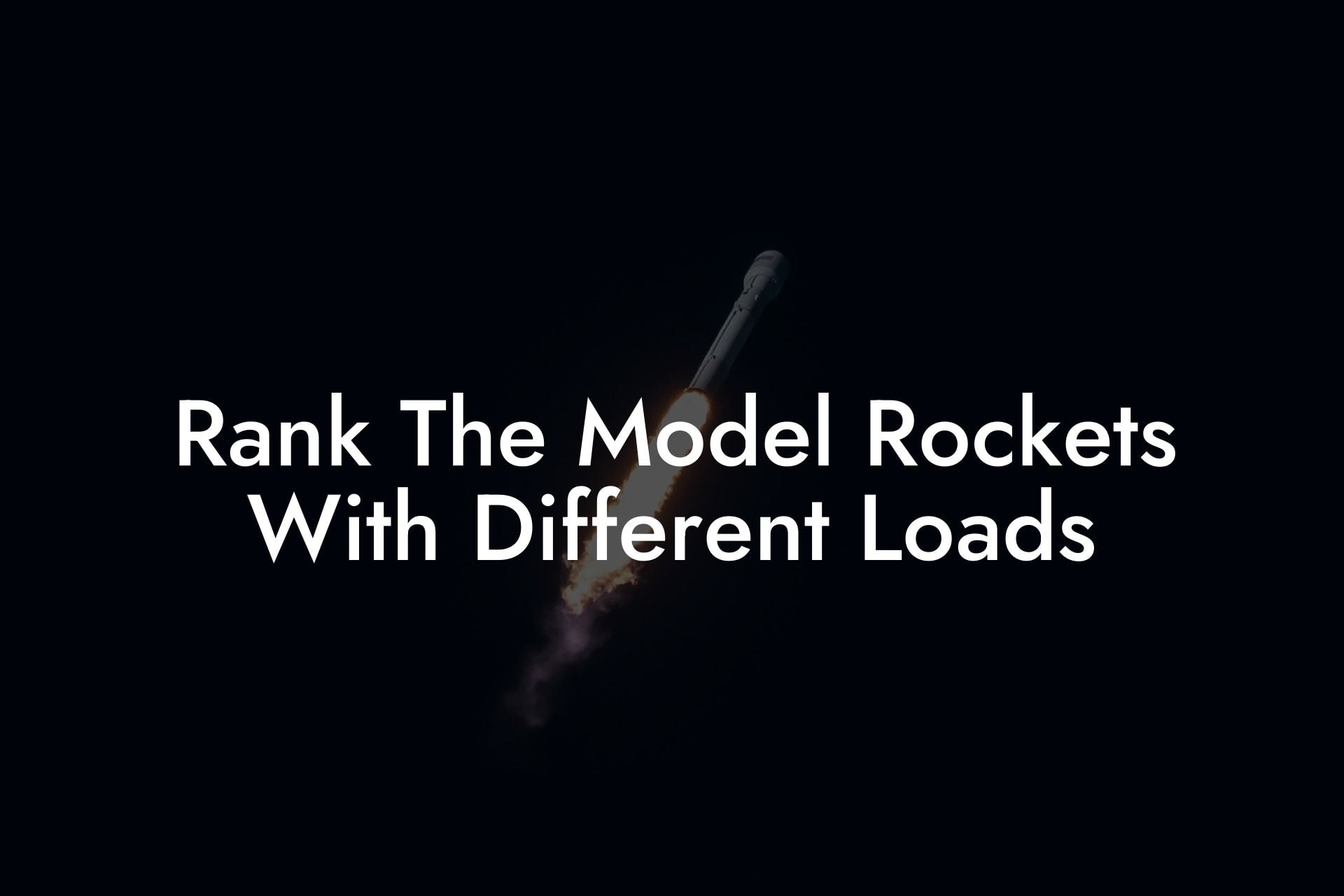Imagine soaring to new heights with your model rocket, effortlessly piercing the sky with a payload of your choice. Whether you're a seasoned enthusiast or just starting out, understanding how to rank model rockets with different loads is crucial for maximizing performance, safety, and fun. Buckle up, because we're about to dive into the world of model rocketry and explore the art of optimizing your flights!
Quick Links to Useful Sections
- What Affects a model rocket's Performance?
- Ranking Model Rockets: A Comprehensive Guide
- Step 1: Determine the Rocket's Mass
- Step 2: Consider Aerodynamics
- Step 3: Analyze Thrust and Drag
- Step 4: Evaluate Stability
- Step 5: Rank Your Rockets
- Real-World Examples: Model Rockets in Action
- Example 1: Estes Tandem-X launch Set
- Example 2: Apogee Aspire
- Example 3: Quest Astra III
- Tips and Tricks for Optimizing Performance
- Resources and community Support: Your Next Steps
- Frequently Asked Questions: Model Rocket Ranking
What Affects a model rocket's Performance?
Before we dive into ranking model rockets, it's essential to understand the key factors that impact their performance. These include:
- Mass: The weight of the rocket, including the payload, affects its acceleration, speed, and overall performance.
- Aerodynamics: The shape and design of the rocket influence air resistance, which can either hinder or enhance its flight.
- Thrust: The power generated by the engine determines the rocket's acceleration and maximum speed.
- Drag: Air resistance, which increases with speed, can slow the rocket down and affect its overall performance.
- Stability: A stable rocket is crucial for a successful flight, as it ensures the rocket flies straight and doesn't wobble or spin out of control.
By understanding these factors, you can begin to optimize your model rocket's performance and make informed decisions when ranking them with different loads.
Ranking Model Rockets: A Comprehensive Guide
Now that we've covered the basics, let's dive into the world of model rocket ranking. Here's a step-by-step guide to help you rank your model rockets with different loads:
Step 1: Determine the Rocket's Mass
Calculate the total mass of your model rocket, including the payload, to understand its effect on performance. A heavier rocket will generally accelerate slower and reach lower altitudes.
Looking For The Best Model Rocket Kits? You'll Love These:
Step 2: Consider Aerodynamics
Evaluate the rocket's shape and design to determine its aerodynamic efficiency. A sleek, streamlined rocket will cut through the air more efficiently, while a bulky design will increase drag.
Step 3: Analyze Thrust and Drag
Calculate the thrust generated by the engine and balance it against the drag forces acting on the rocket. A higher thrust-to-drag ratio will result in better performance.
Step 4: Evaluate Stability
Assess the rocket's stability by checking its center of gravity, center of pressure, and moment of inertia. A stable rocket is crucial for a successful flight.
Step 5: Rank Your Rockets
Based on your calculations and evaluations, rank your model rockets with different loads from highest to lowest performance. Consider factors like altitude, speed, and flight duration to determine the top-performing rockets.
Real-World Examples: Model Rockets in Action
Let's take a look at some real-world examples of model rockets in action, each with different loads and performance characteristics:
Example 1: Estes Tandem-X launch Set
This popular launch set features two rockets with different payloads: a lightweight, high-performance rocket and a heavier, more stable rocket. By ranking these rockets based on their performance, you can determine which one reaches the highest altitude and flies the longest.
Example 2: Apogee Aspire
The Apogee Aspire is a high-performance model rocket designed for advanced enthusiasts. By loading it with different payloads, you can experiment with different performance characteristics and rank its flights accordingly.
Example 3: Quest Astra III
The Quest Astra III is a mid-range model rocket suitable for beginners and intermediate enthusiasts. By ranking its flights with different loads, you can optimize its performance and achieve better results.
Tips and Tricks for Optimizing Performance
Here are some additional tips and tricks to help you optimize your model rocket's performance and improve its ranking:
- Use lightweight materials: Reduce the rocket's mass by using lightweight materials for the payload and structural components.
- Optimize aerodynamics: Use computer simulations or wind tunnel testing to optimize the rocket's shape and design for better aerodynamics.
- Choose the right engine: Select an engine that provides the right amount of thrust for your rocket's mass and payload.
- Experiment with different payloads: Try loading your rocket with different payloads to see how it affects its performance and ranking.
By applying these tips and tricks, you can fine-tune your model rocket's performance and climb the ranks to become a top-performing rocketeer!
Resources and community Support: Your Next Steps
Now that you've mastered the art of ranking model rockets with different loads, it's time to take your skills to the next level. Here are some resources and community support options to help you continue improving:
- Model Rocketry Forums: Join online forums and discussion groups to connect with other enthusiasts, share tips, and learn from their experiences.
- Rocketry Clubs: Look for local rocketry clubs or organizations that offer workshops, launch events, and competitions to help you improve your skills.
- Online Tutorials and Guides: Explore online resources, such as tutorials, guides, and videos, to learn new techniques and stay up-to-date with the latest developments in model rocketry.
By leveraging these resources and community support options, you'll be well on your way to becoming a master model rocketeer and ranking your rockets with confidence!
Frequently Asked Questions: Model Rocket Ranking
Here are some frequently asked questions about ranking model rockets with different loads:
1. What's the most important factor in ranking model rockets?
The most important factor is the rocket's mass, as it affects its acceleration, speed, and overall performance.
2. How do I calculate a rocket's thrust-to-drag ratio?
Calculate the thrust generated by the engine and divide it by the drag forces acting on the rocket. A higher ratio indicates better performance.
3. What's the best way to optimize a rocket's aerodynamics?
Use computer simulations or wind tunnel testing to optimize the rocket's shape and design for better aerodynamics.
4. Can I use different engines for the same rocket?
Yes, you can experiment with different engines to see how they affect the rocket's performance and ranking.
5. How do I ensure my rocket is stable?
Evaluate the rocket's center of gravity, center of pressure, and moment of inertia to ensure it's stable and flies straight.
Looking For The Best Model Rocket Kits? You'll Love These:
Useful Interruption: Dive deeper into the world of Model Rockets with our most popular sections. If there is anything you think is missing or anything you would love for us to write about, just give us a shout.
- Getting Started & Basics With Model Rockets
- Model Rocket Design, Build & Customization
- Model Rocket Propulsion & Engine Technology
- Model Rocket Launch Techniques & Recovery
- Model Rocket Advanced Rocketry & Innovations
- Model Rocket DIY and Customization
- Model Rocket Equipment Reviews & Digital Tools
- Community, Competitions & Education
- Model Rocket Troubleshooting & FAQs
- Model Rocket Bonus/Seasonal & Niche Topics
A group of model rocket enthusiasts gathered at a field for their weekly launch event. Among them was Dave, a seasoned builder known for pushing the limits of hobby rocketry. This time, he had outdone himself.
“Ladies and gentlemen,” Dave announced, dramatically pulling a cloth off his latest creation, “I present to you: The Kraken!”
The crowd gasped. This wasn’t just a model rocket, it was a monster. The thing stood 8 feet tall, had six clustered engines, and was covered in enough duct tape to qualify as a classified aerospace project.
“Dave,” muttered Steve, the cautious safety officer, “Have you, uh… done the math on this?”
“Math?” Dave scoffed. “I built it in my garage at 3 a.m. with parts from eBay. This is an art piece, Steve.”
The countdown began.
5…
4…
3…
2…
1…
The engines ignited with a BOOM, and The Kraken shot up… kind of. It immediately did a violent barrel roll, narrowly missing the spectators before skyrocketing at an angle that could only be described as “legally questionable.”
The crowd collectively ducked as The Kraken flew straight over the adjacent cornfield, where Old Man Jenkins, the grumpiest farmer in town, was minding his business.
KABOOM!
The rocket disappeared behind the barn. A moment later, a flaming piece of Estes igniter wire landed at Steve’s feet. The silence was deafening.
And then, an unmistakable sound echoed across the field.
Jenkins’ shotgun being cocked.
“DAVE!!!” Steve shouted. “RUN.”
And that was the day Dave invented the first-ever biologically powered rocket booster: pure adrenaline.
To this day, nobody knows where The Kraken landed, but legend has it, it still haunts the skies, terrifying unsuspecting drones and low-flying birds.















